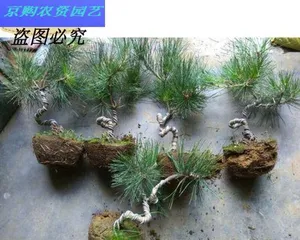Pine bonsai is a type of bonsai loved by many bonsai enthusiasts. However, as time goes by, the nutrients in the soil are gradually depleted, and it becomes necessary to repot the pine bonsai. What are the timing and methods for repotting? This article will provide you with a detailed introduction.

I. Timing for Repotting
1.1 Spring Repotting
Spring is the best time to repot a pine bonsai. As spring arrives, temperatures rise and the weather becomes pleasant, which can stimulate the growth of the pine. Repotting at this time is beneficial for promoting root growth and nutrient absorption.

1.2 Autumn Repotting
Autumn is also a suitable time to repot a pine bonsai. In autumn, the temperature gradually decreases, and plants enter a dormant period. Repotting at this time can provide the pine with sufficient nutrients and will not cause too much damage to the plant.
II. Preparation
2.1 Preparing Tools

Tools needed for repotting include: a broom, a shovel, a bucket, a watering can, etc. Be sure to prepare these tools before repotting.
2.2 Preparing New Soil
The new soil for the pine bonsai should be planting soil with good air permeability and drainage, such as leaf mold, peat moss, etc.
2.3 Preparing Fertilizer
After repotting, it is necessary to add an appropriate amount of fertilizer to the pine bonsai. Fertilizer can be organic or chemical fertilizer, but it should not be excessive.
III. Repotting Steps
3.1 Removing the Pine from the Pot
Take the pine out of the pot and remove any weeds and accumulated fallen leaves from inside the pot. If the roots are dense, you can gently dig them out with a shovel.
3.2 Cleaning the Roots
Clean the roots to remove any soil and debris attached to them. Be careful not to damage or break the roots during cleaning.
3.3 Creating a Drainage Layer
Spread a layer of pebbles or sand at the bottom of the pot, about 1-2 cm thick, to serve the purpose of drainage and aeration.
3.4 Filling with New Soil
Fill the new soil to about one-third of the pot's height. Place the pine in the pot and slowly fill the remaining space with new soil up to the rim.
3.5 Arranging the Roots
Gently hold the roots with your hands to secure them and distribute them evenly in the new soil. Do not break or cut the roots.
3.6 Compacting the Soil
Press the soil in the pot with your hands to ensure the pine bonsai grows stably.
3.7 Watering
After repotting, water thoroughly to allow the new soil to absorb moisture fully and promote root growth. However, do not overwater, as this can affect the growth of the pine.
3.8 Fertilizing
After repotting, you can sprinkle some organic or chemical fertilizer on the soil surface, but not excessively. Fertilizer can promote the growth and flowering of the pine.
IV. Precautions
4.1 Avoid Frequent Repotting
Pine bonsai should not be repotted too frequently; once a year is generally sufficient. Frequent repotting can affect the growth and health of the pine.
4.2 Avoid Using Soil That Is Too Rich
Soil that is too rich can cause the pine roots to lack oxygen, leading to slow growth or death.
4.3 Avoid Using Soil That Is Too Coarse
Soil that is too coarse can scratch the roots of the pine, leading to slow growth or death.
4.4 Avoid Severe Pruning
Severe pruning can lead to slow growth or death of the pine. Pruning should be done in moderation according to the growth of the bonsai.
4.5 Pay Attention to Moisture Retention
After repotting, it is necessary to maintain appropriate humidity to promote the growth and health of the pine bonsai.
4.6 Avoid Direct Sunlight
Direct sunlight can cause the leaves of the pine bonsai to dry out or turn yellow, so direct sunlight should be avoided.
4.7 Protect from Cold and Dryness
Cold and dry climates can affect the growth and health of the pine bonsai, so it is important to keep it warm and moist.
4.8 Pay Attention to Observation
After repotting, it is necessary to carefully observe the growth of the pine bonsai to detect and address any problems with the plant in a timely manner.
Repotting is a very important part of pine bonsai care and must be done at the right time and in the right way. During the repotting process, it is necessary to pay attention to moisture retention, avoiding direct sunlight, and protecting from cold and dryness. Only by repotting correctly can the pine bonsai grow healthily.